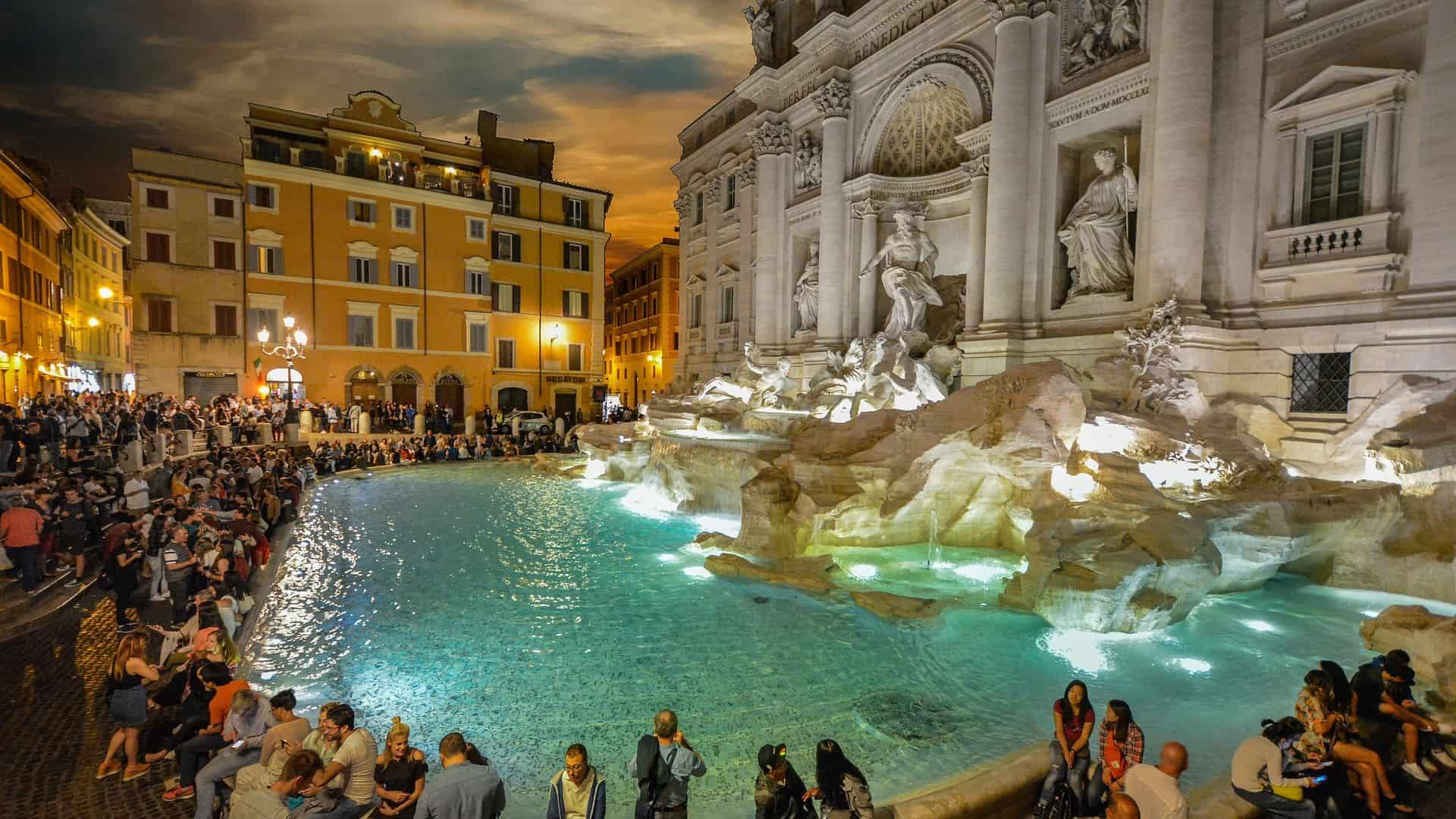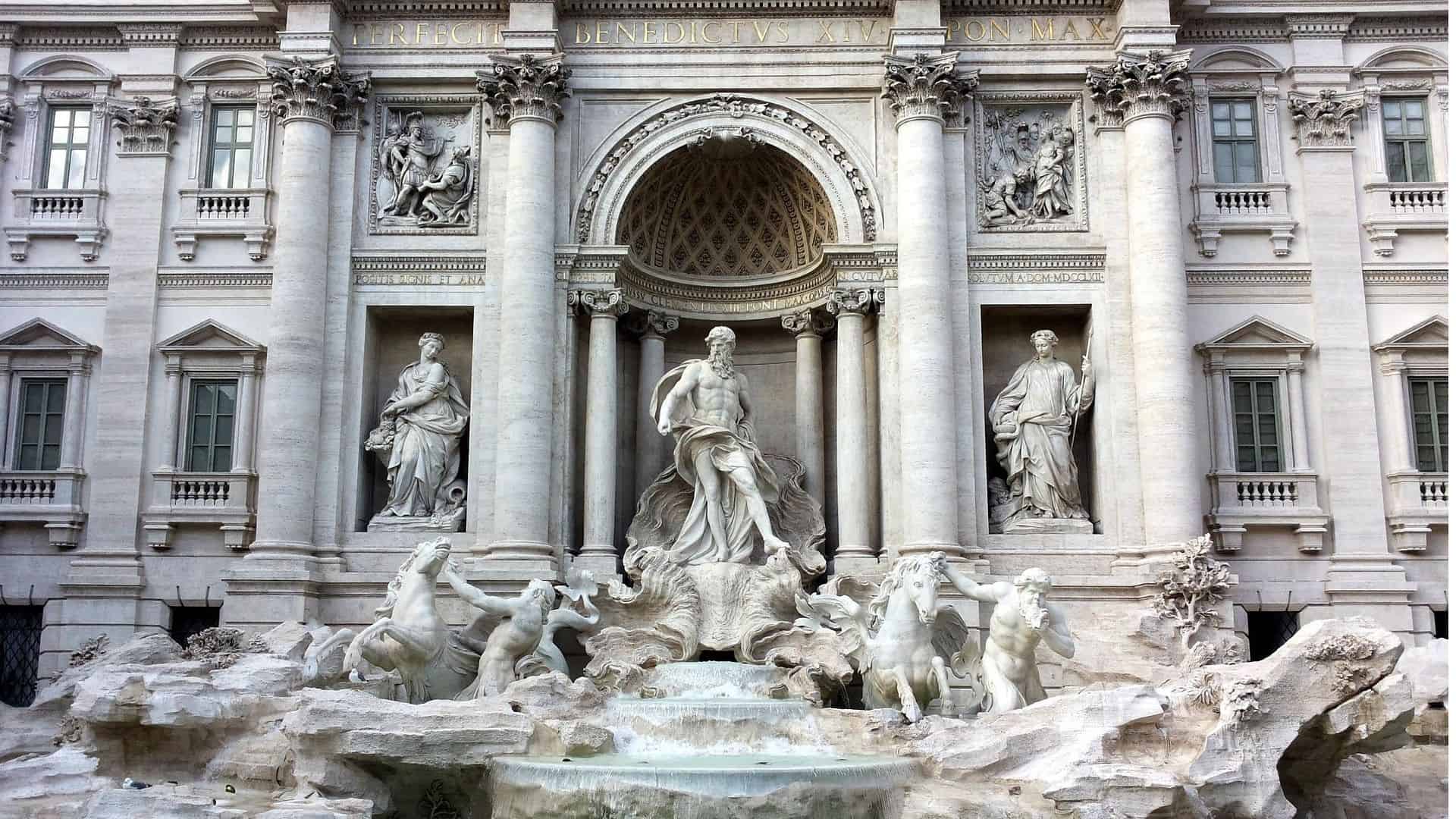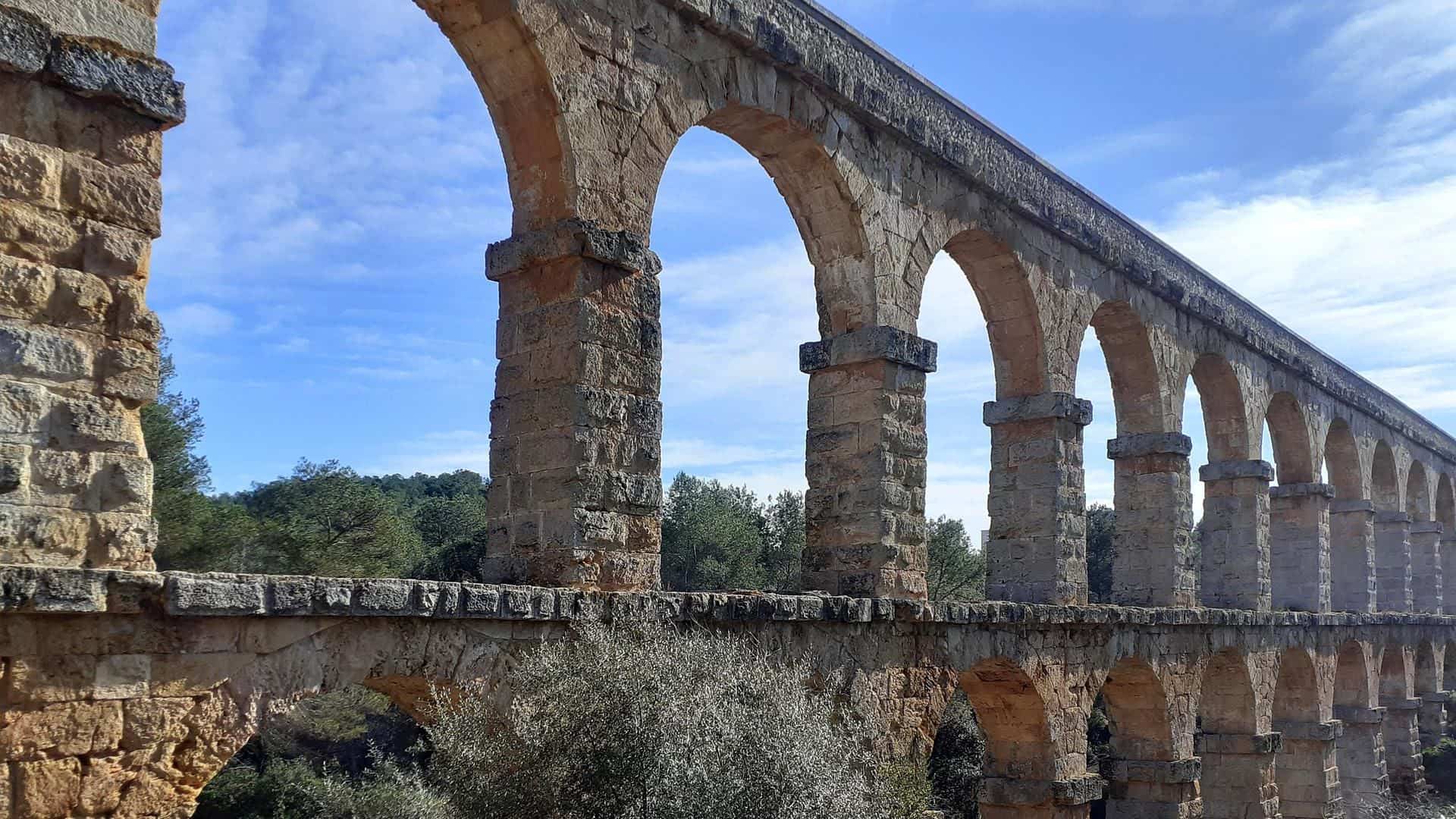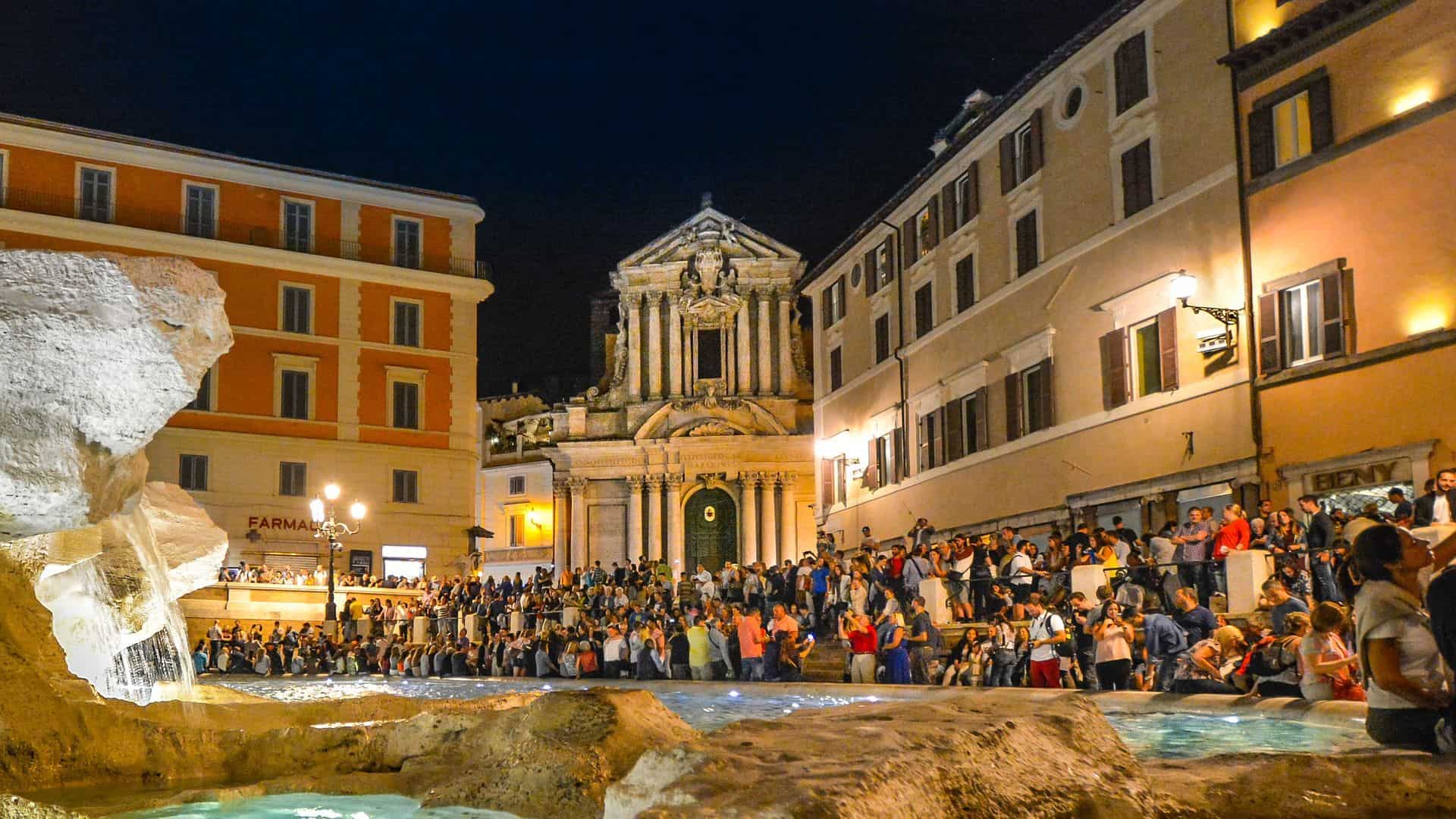Make a wish at the world’s most famous fountain.
The Trevi Fountain needs no introduction. It is known worldwide as being one of the most beautiful fountains ever created. A visit to Rome would not be complete without seeing it.

Highlights
- Toss a coin (or two) into the fountain’s crystal-clear waters.
- Learn about the symbolism behind the beautiful and intricate sculptures that populate the fountain.
- Discover the fountain’s humble beginnings with a peek at an ancient Roman aqueduct.
How to Get There?
My favourite way to get anywhere in Rome is to walk, and the Trevi Fountain is hidden within buildings, so you’ll have to walk a little bit to get there no matter what.
Walking
- Piazza di Spagna (10 min.)
- Pantheon (8 min.)
- Piazza Venezia (9 min.)
- Piazza Navona (12 min.)
But, if you’re coming from a little further away and want to get as close as possible to the fountain by public transport, here’s how you’ll do it:
By Bus
Here are the lines that will take you the closest to the fountain. The stop is: Tritone/Fontana Di Trevi.
- 52, 53, 62, 63, 71
- 83, 85, 117, 160
- 492
Here are the lines that will take you close to the fountain but just slightly further than the above-mentioned lines. These buses will take you to the Largo Chigi stop.
- 51, 119
By Tram
The closest tram to the Trevi Fountain is tram line 8. It will take you to Piazza Venezia, and then you’ll have an 11-minute walk to the Trevi fountain.
From Piazza Venezia, there are also many buses if you’d like to hop on of the lines I mentioned above to get you a little closer to the fountain.
By Metro
The closest metro stop is the stop called Barberini on metro line A. After this, there will be a 7-minute walk with some signs pointing you in the direction of the Trevi Fountain. You can also exit the metro and keep an eye out for any of the bus lines I mentioned above to get you close.
- Be sure to purchase and validate your ticket. There are single-use tickets and other options available, depending on what works best for you or your time in Rome.
| The metro stop you will exit. | Walk the same way as the man in this picture. |
| A view of one of the potential streets you’ll walk down to get to the Trevi Fountain. |
You’ve Arrived, Now What?
Something that I won’t sugarcoat for you is how crazy busy this area will be most of the day. This area will be chaotic if you go at peak hours. I would say peak hours will be starting at around 9 a.m. until anywhere from 10 p.m. to 11 p.m. The beauty will still be there but keep an eye on your bag.
Even with the crazy crowds, there is still a lot to enjoy while you visit the Trevi Fountain. Here’s what I suggest.
| The intro to the crowd in front of the fountain, the beginning of the chaos. |
While Visiting the Trevi Fountain
- Head to the store that faces the fountain, United Colors Of Benetton. Once inside, my advice here is to head up to the second floor and make your way toward the windows that face the fountain. You’ll get a beautiful view, all to yourself. You’ll be able to see the whole fountain without having to worry about keeping a tight grip on your bag to protect yourself from pickpockets.
- If you need to pick up some souvenirs, there are many tourist shops on the streets that lead to the Trevi Fountain. The prices will most likely be a little higher than in other areas of Rome, so if you don’t want to buy anything, don’t be afraid to just window shop.
- Personally, I try to avoid eating and drinking near the Trevi Fountain because of the crowds, prices, and tourist traps in this area. But, if you like the atmosphere and want to soak in a little more of this monument, pick a place nearby and grab some food or gelato.
- There are a few museums in the area, be sure to check them out.
1. Accademia Nazionale di San Luca– A very cool and free museum full of beautiful art and history, but you’ll need to book a private tour.
2. Istituto Centrale per la Grafica– an option for those of you who are more into graphic art. - If you head down the steps in front of the fountain and then go towards the right, you’ll reach my favourite little area of the fountain. This area is home to the ‘Fountain of Love’. It is said that couples who drink from this fountain together will remain in love and faithful forever.
| The photo you’ll get of the Trevi, angling your camera upwards to try to get as few people as possible. | The photo you’ll get from above when you enter the store I mentioned! You’ll capture the whole fountain and the water. |
| The entrance to the store you have to go into to get the perfect view and photo of the Trevi Fountain. |
| The entrance to Accademia Nazionale di San Luca. | A sneak peak into some of the beauty inside. |
| The entrance to Istituto Centrale per la Grafica. |
| The area to the right of the Trevi that I like the most. | The Fountain of Love. |
The Myth Behind the Trevi Fountain Coin Toss
If you look down into the waters of the fountain, you’ll see the floor glittering with hundreds of coins. That’s because, according to legend, depending on how many coins you toss into the fountain, you get different results.
- One coin– Throw one coin in the Trevi Fountain, and it will ensure your return to Rome.
- Two coins– Throw two coins in the Trevi Fountain, and you’ll fall in love with an attractive Italian.
- Three coins– Throw three coins in the Trevi Fountain, and you’ll marry said Italian.
If you’re hoping that your coins in the Trevi Fountain will make these premonitions come to life, be sure to throw your coin/coins in with your right hand and over your left shoulder.
The tradition originated with the aptly named 1954 film, Three Coins in the Fountain and has since become a myth.
The Symbolism of the Sculptures

The main figure in the center of the work is the Titan (the ancestors of the gods), Oceanus, and not Neptune, as most people think. This god of the Sea rides a shell and is flanked by two mer-horses, or hippocampus, each held by a triton. One is docile, while the other is wild, representing the different moods of the sea.
In the niches on either side of Oceanus are two female statues, personifications of Abundance (holding the basket of fruit) and Salubrity (with the laurel wreath). They signify the luxuries that clean water provides. There are four more goddesses at the top of the fountain, each representing the earth’s bounty thanks to water (fruit, crops, harvest, and flowers).
There are also two reliefs that explain the history behind the water source. One depicts a virgin (hence the name Acqua Virgo) showing the Romans where to find pure water; the other shows Marcus Agrippa (who also built the Pantheon) ordering the construction of the aqueduct.
The Ancient Aqueduct

There are still a few places near the fountain where you can see parts of the old aqueduct. One way is to pay a small fee to visit Vicus Caprarius, an underground archeological dig. It shows the original site of the source of the water, as well as the remains of Roman houses.
You can also walk a short distance to Via del Nazareno, across the street from Via del Tritone, and peek through the gate to catch a glimpse of the tops of the aqueduct arches; the rest is buried below street level.
The most unique way to see it, however, is to go to the nearby Rinascente, a huge department store, and descend to the underground level. While restoring the building, they discovered a stretch of the aqueduct and made it available for everyone to see for free.
The Preserved Hearts of the Popes

Right across the street from the fountain is a church with a long name: Santi Vincenzo e Anastasio a Fontana di Trevi. It’s not only a cute church and a great place to seek refuge from the tourists and Roman heat, but it’s also the home to 22 preserved pope hearts.
In a practice that lasted from the 16th century up until 1903, after a pope’s death, he would have his heart removed and preserved here before his body was embalmed. The tradition ended when Pope Leo XIII refused to be subjected to it. Squeamish, maybe?
My Favourite Way to Visit the Trevi Fountain
A lot of people will tell you to wake up early to visit the Trevi Fountain, but personally, I think the better way is to stay up late if you can.
I’ve always loved wandering slowly home after some time out in the evening with friends in Rome. The city is still as beautiful as during the day, but the crowds are much less.
If you’re out for dinner or drinks, don’t rush. Take your time enjoying the food and drinks, and then slowly wander around the city on your way home.
Try to make your path take you across as many monuments as possible, but especially the Trevi Fountain, as it’s warmly lit under the warm, yellow lighting of Rome at night.
| How the Trevi Fountain will look late night/early morning. No crowds and almost all to yourself. Sit and take in the fountain shining at night. |
After the Trevi Fountain
The Trevi Fountain is very central, so you have lots of options of what to do after visiting the Trevi Fountain. Here are some ideas.
- Check out the museums I mentioned earlier.
- Head towards the Spanish Steps.
- Do some shopping in Via del Corso.
Remember
Don’t let the crowds ruin the beauty for you. Take your pictures, throw your coins, and make your memories no matter what.
Did You Know That: 4 Interesting Facts
- The fountain is located at the junction of three roads, which is where it gets its name: Trevi derives from Tre Vie, which literally means ‘three streets’.
- It’s estimated that around one million euros are collected from the fountain each year. The money is then sent to a local charity to help the poor.
- One of the most famous scenes in movie history took place here when Anita Ekberg wades into the fountain in La Dolce Vita. Don’t try it today. You’ll get fined.
- The fountain is the finishing line for a working aqueduct named the Acqua Vergine, which provides clean drinking water to the city of Rome.
History
- The site where the fountain sits today was actually the terminal point for an important Roman aqueduct, the Acqua Virgo, built-in 19 BCE. It’s the predecessor to Acqua Vergine.
- The aqueduct served ancient Rome for over 400 years until it was damaged sometime during the 6th century during an invasion by the Ostrogoths.
- In 1453, Pope Nicholas V built the first fountain on this site, during his restoration of the aqueducts. It was the only source of clean water in Rome for nearly 100 years.
- Pope Urban VIII thought the fountain was too modest, so, in 1629, he asked Gian Lorenzo Bernini to design a much more magnificent fountain to replace it.
- The project fell through after the pope’s death and Bernini’s vision was never created, though you can still see some of his influence on it today.
- The fountain was left alone again until 1730, when Pope Clement XII held a contest to select an architect to redesign it.
- The architect Nicola Salvi was awarded the commission (even after having lost the contest to a Florentine, to the dismay of the Romans) and started carving the intricate details out of travertine stone. Unfortunately, he would never live to see it finished.
- It was finally completed thirty years later, in 1762, by architect Giuseppe Pannini and a team of sculptors and inaugurated by Pope Clement XIII later the same year.
- Today, the Trevi Fountain is considered one of the most beautiful and well-known fountains in the whole world and is visited by millions of people a year.
FAQs
The Trevi Fountain is famous for its detailed artwork and intricate sculptures. It’s an unmissable sight, being the biggest fountain in Rome, measuring 20 meters in width and 26 meters in height.
The main figure in the center of the Trevi Fountain is Oceanus, and not Neptune, as many people think.
The coins thrown in the Trevi Fountain are collected, cleaned, and given to a Catholic charity, Caritas in Rome.
It’s estimated that around one million euros are collected from the fountain each year.
Address: Trevi Fountain, Piazza di Trevi , 00187 Roma, Italy · view larger map